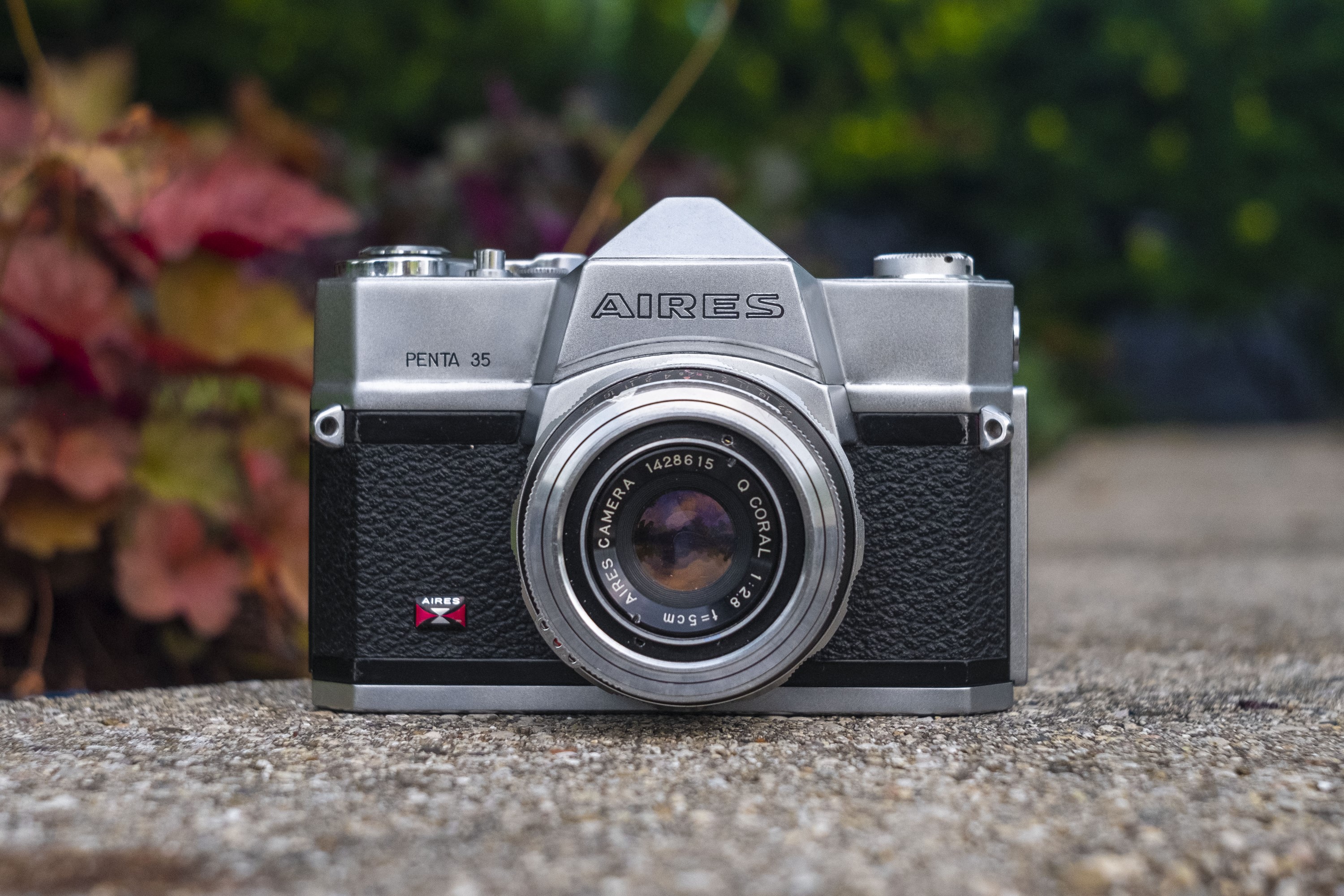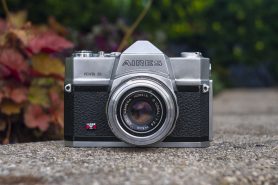This is an Aires Penta 35, a single lens reflex 35mm film camera produced by Aires Camera Ind. Co., LTD between 1959 and 1961. The Penta 35 was the first and only SLR camera produced by Aires before they went out of business and was seen as a last ditch effort to make the company profitable. The Penta 35 uses a between the lens Seikosha leaf shutter and most have a fixed 5cm f/2.8 lens. A pair of auxiliary wide and telephoto lenses were available that would screw onto the lens using the filter threads. A very small number of Penta 35s were equipped with a faster f/2 H-Coral lens, and some with an uncoupled selenium meter. The camera was also sold under the names Reflex 35 and Ever.
Film Type: 135 (35mm)
Lens: 5cm f/2.8 Aires Q-Coral coated 4-elements in 3-groups
Focus: 2.67 feet to Infinity
Viewfinder: Fixed SLR Pentaprism
Shutter: Seikosha SLV Leaf
Speeds: B, 1 – 1/500 seconds
Exposure Meter: None
Battery: None
Flash Mount: PC Port with M and X Flash Sync
Weight: 802 grams
Manual: https://www.cameramanuals.org/pdf_files/aires_penta_35_single.pdf
How these ratings work |
The Aires Penta 35 was the first and last SLR produced by Aires and one of the company’s last cameras made before they went out of business. It’s existence appears to be a last ditch effort for the company to stay in business, but in a case of “too little too late” the camera was outdated by the time of it’s release, offering no compelling reason for customers to buy it other than value. As a result, the camera sold poorly and perhaps a result of some quality control issues the camera has not aged well. Many examples of these leaf shutter SLRs have some combination of a frozen shutter and stiff focus, making finding one in usable condition today, difficult. | ||||||
| Images | Handling | Features | Viewfinder | Feel & Beauty | History | Age | |
| 1 | 1 | 1 | 1 | 1 | 1 | 30% | |
| Bonus | none | ||||||
| Final Score | 7.8 | ||||||
History
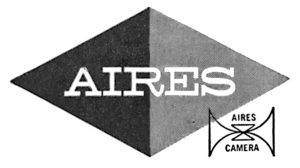 After World War II ended, the Japanese camera industry was wide open. Pre-war companies like Canon, Nippon Kogaku (Nikon), Chiyoda Kogaku (Minolta), and Konishiroku (Konica) started churning out model after model of new cameras and other photographic products. Joining them were several newcomers like Asahi Optical (Pentax), Miranda, Yashima (Yashica), and Aires.
After World War II ended, the Japanese camera industry was wide open. Pre-war companies like Canon, Nippon Kogaku (Nikon), Chiyoda Kogaku (Minolta), and Konishiroku (Konica) started churning out model after model of new cameras and other photographic products. Joining them were several newcomers like Asahi Optical (Pentax), Miranda, Yashima (Yashica), and Aires.
Japan’s economy was destroyed as a result of the war, so in an effort to inject some money into Japanese industry, American occupation forces sought out companies who could build and sell things to western countries like the United States. Cameras and lenses were popular items as the Japanese had a knack for building quality devices that came close to, and in some cases, exceeded the quality of similar products from Germany, who up until them was a world leader in this industry.
Between 1950 and 1960, the photographic world changed, and Japanese products went from economical curiosities to industry leaders. As the Japanese camera industry grew, so did it’s leaders. Nippon Kogaku and Canon became two of the most respected optics companies in the world, but as they grew, it left little room for some of the smaller companies.
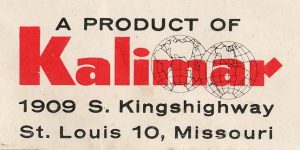
One such smaller company was Aires, who had produced a couple different medium format twin lens reflex and 35mm rangefinder cameras that for one reason or another, failed to stand out in the market. If based solely on quality and capability, Aires cameras should have easily matched their contemporaries, but it seems that the company struggled with distribution, especially in the United States. By the end of the 1950s, Aires’s US distributor Kalimar was more interested in releasing products made by third party companies and selling them under their own Kalimar house brand, than promoting Aires.
By the end of the decade, Aires found themselves in financial trouble not only due to slow sales, but a lack of innovation, and the ability to get away from dated TLR and rangefinder designs meant that they could not compete with new and exciting models being produced by the competition.
As one last ditch effort in 1959, Aires produced it’s first and what would be it’s only SLR, the Aires Penta 35. Unlike other Aires rangefinders which were innovative and built to a high quality standard, the Penta 35 was a run of the mill leaf shutter SLR, a design that was overly complex and already starting to lose favor to focal plane shutter SLRs being released by other companies.
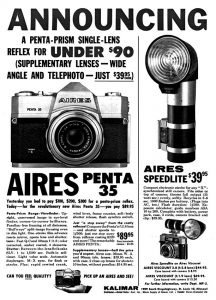
The Penta 35 lacked an instant return mirror, an exposure meter, and an interchangeable lens mount, meaning that only with screw on auxiliary 36mm wide angle and 90mm telephoto lenses, could different focal lengths be achieved. When it went on sale in the US, it carried a retail price of $89.95 for the camera only, and each auxiliary lens was $39.95 each. When adjusted for inflation, these prices compare to $835 and $370 today, certainly not cheap, but a lot less than competing SLRs of the day.
A year later, a couple different variants of the Penta 35 were released, some with an upgraded f/2 lens, and some with an uncoupled selenium exposure meter on the front face of the pentaprism. Models with the meter and faster lens were still sold as the Penta 35, but versions only with the faster lens were sold as the Aires Reflex 35 and Aires Ever in different markets.
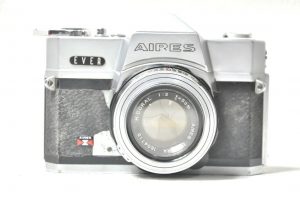
Contrary to information online about the Aires Ever being a completely different model, the Ever is simply a regular Penta 35 exported to other countries with a faster lens. Perhaps an updated Aires Ever was planned that would have been a new model, but I’ve never seen such an example of one.
As was the case with many last models by a huge number of companies that went out of business, the Penta 35 was ‘too little too late’. Yes, the world was moving away from rangefinders to SLRs, but an uninspired and basic leaf shutter SLR was already old news in 1959 and certainly couldn’t overcome a lack of brand recognition and questionable distribution.
Aires would hang on until about 1961 with it’s last model, the Aires Radar Eye barely making a blip on the radar of Japanese cameras, before going out of business for good. Sadly, unlike other optics companies that would go out of business, Aires was not absorbed into or acquired by any other company, merging their expertise with another’s, they just disappeared.
Today, Aires rangefinders have a small, but loyal following of people such as myself who respect their earlier efforts as solid cameras that are easy to use and come with great lenses. This positive reputation does not extend to the company’s one and only SLR however. The Aires Penta 35 is a largely forgotten model that is rarely sought after, and for the few people who do have one in their collection, a complex and unreliable shutter typically means that most don’t work today.
My Thoughts
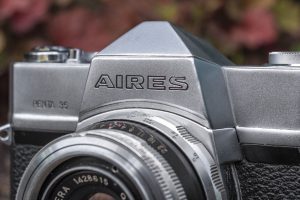
For as small of a company Aires was, I sure have written a lot about them on this site, with reviews of the 35-III L, 35-V, and Radar Eye, I have consistently given high marks to Aires rangefinders as I found them well built, easy to use, and had lenses capable of outstanding results. I knew Aires had a short history, but upon learning of one single SLR model near the end of the company’s existence, I wanted to see how it lived up to their excellent rangefinders.
Upon picking up the Aires Penta, it is clear the camera shares some rangefinder DNA. The film advance lever looks like a rangefinder parts bin part, and it shares the same extra stiff effort that every single Aires rangefinder requires to move. Like other leaf shutter SLRs, the Penta is a bit taller and narrower than focal plane SLRs, giving it a sense of heft and density not unlike other Aires cameras. The overall design of the camera is clean and from the front has a bit of symmetry which I always appreciate.
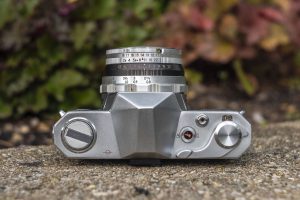
Like most SLRs, the top plate is dominated by the pentaprism hump, flanked on the left by the pop up rewind knob and on the right, an advance/rewind knob, cable threaded shutter release, film advance lever, and automatic resetting exposure counter.
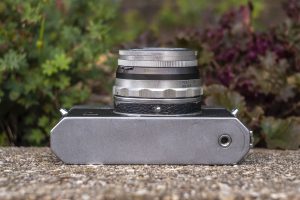
Flip the camera over and the bottom has a 1/4″ tripod socket, and nothing else. The tripod socket’s location on the side is unfortunate as combined with the camera’s weight, means that when perched on a tripod, there is constant weight to one side which could cause trouble in certain circumstances. I own two Aires Pentas and only one has a small little foot on the bottom of the shutter which helps stabilize the camera on a flat surface. It does not appear on the other, suggesting this was a mid model change.
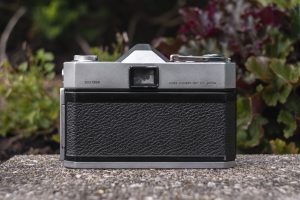
The back of the Penta is about as bare as the bottom, with only the rectangular eyepiece, serial number, and Aires camera engravings.
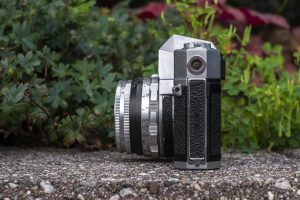
The camera’s left side is where you’ll find the sliding door release for the film compartment, PC flash sync connector, and one of the forward facing strap lugs.
The relatively short depth of the Penta’s fixed Coral lens and Seikosha shutter, combined with the tall top plate, gives the camera somewhat of a compact side profile which helps offset the weight of the camera.
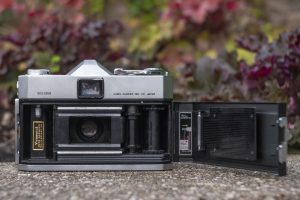
Opening the right hinged door reveals a pretty ordinary film compartment. Save for the lack of a focal plane shutter, the Penta could be mistaken for that of many other SLRs from the 60s and 70s. Film travels from left to right onto a fixed, double slotted take up spool.
Inside the door is an Aires sticker reminding how to attach the leader to the spool, an oversized and dimpled film pressure plate and a chrome roller which helps reduce friction as film transports through the camera.
The Penta predates the use of foam light seals and has cloth and yarn seals on the hinge and through the film channels, both of which were in good enough shape that I didn’t think they needed replacement.
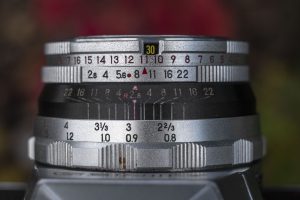
The Penta uses a Seikosha-SLV leaf shutter, and like all most leaf shutter cameras, controls for focus, shutter speed, and aperture are found on the shutter itself. Also like most leaf shutter SLRs, the Penta uses a coupled LVS system and HERE WE GO AGAIN….I hate it.
As I say in nearly every review for a camera with LVS, you cannot independently control both shutter speeds and aperture settings without somehow defeating the LVS. The one found here is marginally less bad than other implementations of the system, as defeating it simply requires you to hold one ring steady while manually turning the other. At least there’s no tiny pin to fight with like on other cameras. In use, it’s something you’ll eventually get used to, and if you shoot a majority of your photos in a similar lighting condition, you won’t have to mess with it much, but I sympathize with someone who might shoot the Penta in constantly changing light.
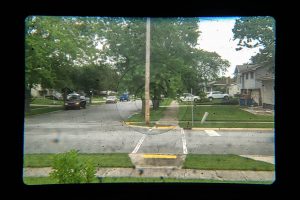
The Aires Penta has a bright and evenly lit viewfinder, thanks to the thick Fresnel focusing screen. In the era when the Penta was made, manufacturers struggled to find the balance of a bright viewfinder while also being able to offer full screen focusing. Many cameras like the Zeiss-Ikon Contaflex and Leitz Leicaflex chose brightness, and in each of those cameras, focus can only be seen through the central split image focusing aide, or a frosted ground glass circle.
The Penta is odd in that there is a non-Fresnel circle around the central split image aide, except this circle doesn’t do anything. It is neither frosted, nor does it have any kind of microprism pattern to help with focus. The only way you cam focus this camera is using the split image aide, and that’s all. This is definitely a con, and not something a company wanting to enter the world of SLRs would want to do. Sure, it’s bright, but not very usable.
In use, the Aires Penta is about as basic of an SLR as you’ll find. It lacks innovation or anything to separate it from other models that were available upon it’s release, and as a camera that was seen as a last ditch effort to save an unprofitable camera, this was a problem. Aside from my frequent complaint about the LVS and the viewfinder, there is nothing offensively bad about the camera, but there’s little to really get excited about either. In handling the camera without film loaded, my fondness for Aires rangefinders does not seem to translate to the company’s only SLR. But of course, that’s without film. Would it’s results be enough to change my opinion about the Penta?
My Results
My first Aires Penta 35 was dead on arrival, so when I got this second one, I was happy to see that the camera worked…sorta. The shutter did fire, but was sluggish at the slow speeds and would stick at whatever first exposure I made after the camera sat. If I set the shutter speed to a faster speed, each subsequent shot after the first one would seem to fire OK. The aperture and focus rings were also very stiff, and the viewfinder was dirty. But it worked. I figured, I’d just set the shutter to a fast speed, waste a shot and then fire off a bunch in quick succession before it would slow down again, and hope for the best. I loaded in some bulk Kodak TMax 100 as it has a lot of latitude and I had a lot of it, so I didn’t mind losing a couple extra shots as it wasn’t a rare film.
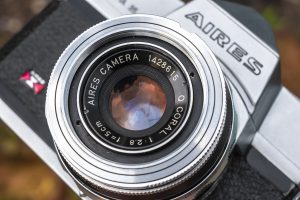
Quoting myself, “so when I got this second one, I was happy to see that the camera worked…sorta”.
If by sorta, I mean a camera that I had trouble seeing focus on, had a hazy lens, a shutter that didn’t always fire, and a stiff focus ring that instead of loosening up with use, actually got stiffer the more I used it, then yes, it worked! I was amazed that I was able to finish an entire roll through this camera.
I realize it is not fair to judge a camera by a single 62 year old example that likely has not had any service in half a century or more, but considering the only other one I’ve come across didn’t work at all, I figured this was the best it would get.
Unlike Aires rangefinders which I have generally enjoy using, the Aires Penta was a miserable experience, and that’s not even counting the conditional issues it had. Had this camera been made in the early 1950s or earlier when how an SLR should work wasn’t quite yet established, I could probably be more forgiving, but by 1959, Aires should have done more for this model.
Putting on my imagination cap, I think that even if I had a perfectly working camera, I don’t know that I could come up with many good things to say about it. Perhaps the Coral lens, which when found on other Aires cameras, would have produced wonderful “Tessar-like” results, but the one on this example was hazed up and produced murky images that I just couldn’t get excited about.
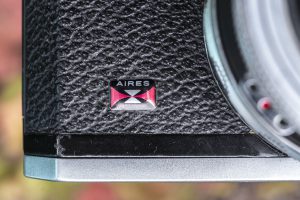
I did not care for the viewfinder at all. It was not unusual for cameras of this era to have Fresnel viewing screens that can’t focus on the edges of the screen, but they would usually have a ground glass circle that could. With the Penta 35, your only option for focus was the small split image focusing aide. While I had no issue with similar viewfinders in the Leitz Leicaflex, it seemed more of an issue for me on the Penta. Every time I put the camera to my eye, it felt like a chore. The stiff film advance, stiff focus, and stiff exposure settings certainly didn’t help matters either.
If the best thing I can say about the Penta, is that when the camera was new, it probably did a fine job, but otherwise was an unremarkable camera only adds additional emphasis to Aires’s failure. By 1959, the company should have already had an idea of what needed to go into the company’s first SLR, and with looming financial problems, should have tried harder to save themselves.
But they didn’t, the Penta sold poorly, and within two years after it’s release, the company went out of business, which I guess is a fitting way to end this review. Normally I like my reviews to have a minimum of 3000 words, but I’ll have to end this one with 2969. Move on folks, there’s nothing else to see here…
Related Posts You Might Enjoy
External Links
https://camerapedia.fandom.com/wiki/Aires_Penta_35
https://www.photo.net/discuss/threads/an-unusual-aires.514123/
http://www.collection-appareils.fr/x/html/appareil-3234.html
http://corsopolaris.net/supercameras/aires/aires.html
http://www.asahi-net.or.jp/~RD2H-ARI/BUN_PENTA.htm (in Japanese)

